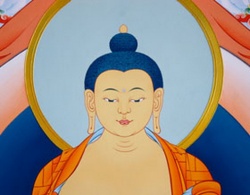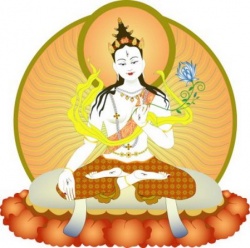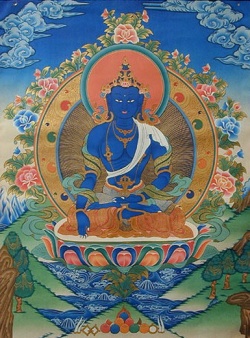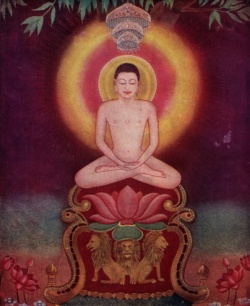Shambhala in the Kalki Purana
Email....okarresearch@gmail.com
"The Kalki Purana (Sanskrit: कल्कि पुराण Kalki purāṇa) is a prophetic work in Sanskrit that details the life and times of Kalki, the tenth and final of the Dashavatara (the ten Avatars) of the Hindu deity Lord Vishnu. The narrative is set in the distant 4,320th century, near the end of the Kali Yuga or Dark Age, as revealed by the storyteller Suta……As a prophetic work, the Kalki Purana writes details about events believed by Hindus to occur in the future. The work is essentially a derivation of passages collected from various Puranas describing the same subject. The work primarily describes the onset and exponential increase of evil and sin on the earth during the Kali Yuga, and the life of Kalki, who is said to bring an end to the darkness of the Kali Yuga, destroying evil and sin, and beginning a new yuga (age) of sinlessness and peace known as the Satya Yuga."….http://en.wikipedia.org/wiki/Kalki_Purana
Kalki…..In Hinduism, Kalki (Devanagari: कल्कि; meaning 'Eternity,' 'White Horse,' or 'Destroyer of Filth') is the final incarnation of Vishnu in the current Mahayuga, foretold to appear at the end of Kali Yuga, the current epoch. Religious texts called the Puranas foretell that Kalki will be atop a white horse with a drawn blazing sword. He is the harbinger of end time in Hindu eschatology, after which he will usher in Satya Yuga…..The name Kalki is a metaphor for eternity or time. Its origins may lie in the Sanskrit word kalka which means foulness or filth. Hence, the name translates to the 'destroyer of foulness,' 'destroyer of darkness," or 'destroyer of ignorance.' Another etymology from Sanskrit is 'white horse.'......In Buddhist Kalachakra tradition, 25 rulers of the Shambhala Kingdom held the title of Kalki, Kulika or Kalki-king. During Vaishakha, the first fortnight in Shukla Paksha is dedicated to fifteen deities, with each day for a different god. In this tradition, the twelfth day is Vaishakha Dwadashi and is dedicated to Madhava, another name for Kalki."….http://en.wikipedia.org/wiki/Kalki
Madhava….a name of Shiva, another name for Kalki. "Dashavatara (Daśāvatāra) refers to the ten avatars of Vishnu, the Hindu God of universal preservation. Etymologically, Dashavatara (Sanskrit: अवतार, derives from daśa, meaning 'ten' and avatāra, meaning 'descent'). God Vishnu incarnates on Earth from time to time to eradicate evil forces, to restore the dharma and to liberate the worthy ones or devotees from the cycle of births and deaths."…..http://en.wikipedia.org/wiki/Dashavatara
"The Twenty-Five Kalki (Tib. Rigden)……The most recent 25 of the 32 Kings of Shambhala are known as Kalki kings (Tib. Rigden, wylie: rigs ldan). Kalki means "Holder of the Castes." The Kalki King is said to reside on a "lion throne" in Kalapa, the capital city of the Kingdom. They are holders of the Kalachakra (Wheel of Time) teachings of Buddha Shakyamuni, passed down from the original seven Dharmarajas of Shambhala……The Kalki have often been erroneously termed "Kulika" by Tibetan Buddhist scholars unfamiliar with the original Sanskrit texts, as Buddhist scholar John R. Newman explains: .. . so far no one seems to have examined the Sanskrit Kalachakra texts. The Buddhist myth of the Kalkis of Shambhala derives from the Hindu Kalki of Shambhala myths contained in the Mahabharata and the Puranas. The Vimalaprabha even refers to the Kalkipuranam, probably the latest of the upapuranas. This relationship has been obscured by western scholars who have reconstructed the Tibetan translation term rigs ldan as "Kulika." Although Tibetan rigs ldan is used to translate the Sankrit kulika in other contexts, here it always represents Sanskrit kalkin (possessive of kalkah; I have used the nomininative kalki)."……http://en.wikipedia.org/wiki/Kings_of_Shambhala
Koka and Vikoka…"According to the Kalki Purana, the twin brothers Koka and Vikoka serve as generals under the demon Kali, overlord of Kali Yuga. In their battle against Kalki, the 10th and final avatar of Lord Vishnu, the brothers display their mastery over the dark arts by raising themselves from the dead faster than Kalki can kill them….Lord Brahma eventually appears to Kalki during the battle and reveals to him that the twin devils had received from him a boon of "Immortality". No earthly or celestial weapon can kill them if they are allowed to hold onto one another…..The names and deeds of these demon brothers are comparable to Gog and Magog in the Bible and Ya'jooj Wa Ma'jooj (يأجوج و مأجوج) of Muslim tradition as they are mentioned in the Qur'an."…http://en.wikipedia.org/wiki/Koka_and_Vikoka
Satya Yuga…."After the defeat and destruction of evil on earth, the Satya Yuga (Golden Age) begins. Kalki will divide the earth into earthly kingdoms among his generals, then perform the Ashwamedha and Rajasuya sacrifices for the Devas. Sumati and Vishnuyasha, his parents, will then travel to the holy place of Badrikashram, where they will live until their death. Having finished his mission of restoring peace, Kalki will appear as Vishnu in his four-armed form, and return to Vaikuntha ……After the siring of Kalki's other sons Meghamaal and Balahaka, Kalki will reign on earth for 1,000 years as the king of Shambhala."….http://en.wikipedia.org/wiki/Kalki_Purana
"A few weeks after Shri Maha-kailasa-nilaya Nirmala Devi had taken Kash to visit Shri Shiva meditating on Mount Kailash -
"Among the upa-puranas or sub Puranas, the Kalki Purana is most sacred and widely respected. At the end of Kali -yuga, the Supreme Lord, Hari, will incarnate as Lord Kalki and kill all the mlecchas, yavanas, atheists, and Buddhists of the world that defy the Vedic authority. The pastimes of Lord Kalki are the subject matter of this literature, which is presented in story form. Exalted personalities can see everything, past, present and future. For this reason, there is no fault in narrating these future events as if they had already occurred. The Kalki Purana consists of thirty-five chapters."…..http://www.exoticindiaart.com/book/details/sri-kalki-purana-IDK367/
Some Chapters of the Kalki Purana…..
13…..Visvakarma Reconstructs the village of Sambhala…. The Arrival of Lord Kalki…..
14…..Lord Kalki Conquers the Buddhists Who Opposed Him…..
15…..Lord Kalki Is Attacked BY The Mleccha Women Instruction by the Weapons Personified…..
16…..The Killing of the Raksasi, Kuthodari…..
17…..The Descendents of the Surya Dynasty Lord Ramacandra's Pastimes…..
……..http://www.exoticindiaart.com/book/details/sri-kalki-purana-IDK367/
"Kalki Puranas…..deals in detail with the descent of the tenth incarnation, his life on earth, the various battles fought by him, his marriage and his final return to the Vaishnava paradise (vaikunth) via the Himalayas…. Nothing can be said for certain about its date of composition. The text may not be very old, but since it describes the triumph of the Brahmanical religion over Buddhism and Jainism viewed as heresies one can say at least that it reflects a period between the seventh and the twelveth centuries when these religious traditions were on the decline….as told in the Kalki Purana can be summed up as follows. The future avatar of Vishnu, said to be the son of a Brahmin named Visnuvyasa, has received from the god Shiva a miraculous sword, a parrot and a winged horse of white colour whose name - given as Devadatta (litt. "given by the gods") in the Bhagavata Purana (Stutley, Ibid.) - is not indicated in this text. His fiercest enemy for whose destruction he will become incarnated is Kali or Kali Yuga, the personification of the last of the four yugas, symbolizing all its evils. But Kalki will also have to fight against human enemies, mainly represented by Buddhists and Jains. After his victory he will marry two Ksatriya princesses and his mission on earth being accomplished he will retire to the Himalayas where he will spend his days in meditation.…



